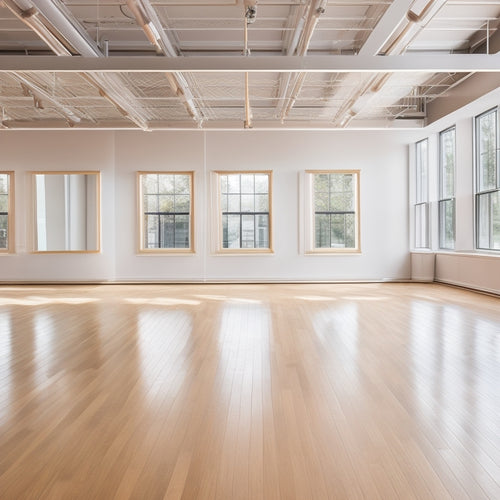
Expert Tips for Perfect Dance Dress Fabrics
Share
When it comes to crafting a show-stopping dance dress, I know that selecting the perfect fabric is essential, as it can make or break the overall aesthetic and performance of the garment. I consider the impact of color on visual effect, choosing fabrics that enhance the design and desired look. I test fabric weight, stretch, and recovery to make sure it accommodates the dancer's movements. By prioritizing peak stretch fabric performance and strategically incorporating accents, I create a dress that's both functional and visually stunning. Now, let's dive deeper into the specifics that can elevate your dance dress design to the next level.
Key Takeaways
• Choose fabrics that enhance your design and desired look, considering the impact of color on visual effect.
• Select fabrics with suitable weight to achieve the desired drape and flow for your dance dress.
• Prioritize peak stretch fabric performance, durability, and recovery for optimal dance dress functionality.
• Strategically incorporate accent fabrics like metallic or glittering materials to elevate your design and create visual interest.
• Conduct stretch testing to ensure your fabric accommodates dancer's movements and assesses elasticity and resilience.
Mastering Fabric Selection Essentials
When selecting fabrics for dance dresses, I consider the impact of color on the visual effect, as it can greatly influence the overall appearance of the garment. I choose fabrics that enhance the design and desired look, keeping in mind that light colors can make one look larger, while dark colors have a slimming effect.
Fabric weight is also vital, as it affects the drape and flow of the dress. I always conduct stretch testing to make sure the fabric can accommodate the dancer's movements. Pre-treatment techniques, such as pre-washing and pre-treating, are essential to prevent shrinkage and distortion.
Optimizing Stretch Fabric Performance
I prioritize peak stretch fabric performance by carefully selecting high-quality fabrics that can withstand the demands of dance movements, considering factors like durability, flexibility, and recovery.
When choosing stretch fabrics, I give priority to those with exceptional stretch fabric durability to make sure they can handle the rigors of dance.
Fabric stretch testing is vital to assess a fabric's ability to stretch and recover. I conduct a series of tests, including the 'stretch and recovery' test, to evaluate the fabric's elasticity and resilience.
By doing so, I can confidently select fabrics that will perform excellently under the stresses of dance movements.
This attention to detail ensures that my dance dresses not only look stunning but also provide the necessary comfort and flexibility for top-notch performance.
Elevating Design With Accents
By strategically incorporating accents, I can take my dance dress designs to the next level, adding visual interest and dynamic flair that captivates the audience. Accent embellishments can elevate my design, creating a show-stopping effect.
I achieve this by thoughtfully selecting accent fabrics, such as metallic or glittering materials, to add depth and dimension to my designs. By applying these accents strategically, I can create design enhancements that draw the eye to specific areas of the dress, accentuating movement and flow.
For example, adding a sparkling waistband or intricate lace appliqué can transform a simple design into a stunning showpiece. By balancing accent elements, I can create a truly unforgettable dance dress.
Frequently Asked Questions
Can I Use Cotton Fabrics for Dance Dresses That Require Stretch?
Personally, I'd advise against using cotton fabrics for dance dresses requiring stretch, as they have limited stretch capabilities, and opting for cotton blends with elastane or spandex can help push the stretch limits.
Do I Need to Line Dance Dresses Made From Transparent Fabrics?
"As I slip into my dance dress, I ponder: do I need to line transparent fabrics? Yes, to avoid show-through, I'll choose a lining that complements the fabric weight, opting for sheer options like power mesh or silk habotai for a seamless look."
How Do I Prevent Pilling on Velvet Dance Dresses Over Time?
To prevent pilling on my velvet dance dresses, I use gentle cleaning products, avoid machine washing, and store them in a cool, dry place to maintain fabric longevity and prevent pilling over time.
Are Sequins or Beads Better for Adding Sparkle to Dance Dresses?
When adding sparkle to my dance dresses, I prefer hand-beaded embellishments for a more subtle, intricate look, whereas machine-applied sparkles provide a bold, eye-catching effect, depending on the desired level of drama and visual impact.
Can I Use the Same Fabric for Both the Bodice and the Skirt?
"I opt for contrasting fabrics for the bodice and skirt to create visual interest; a matte bodice pairs beautifully with a flowy, shimmering skirt, adding fabric contrast and maximizing skirt drama."
Related Posts
-

Group Dance Makeup Tutorials for Online Success
As you immerse yourself in the world of group dance makeup tutorials, you'll need to master essential makeup techniqu...
-

Best Studio Mirrors for a Professional Dance Space
Choosing the best mirrors for your professional dance space can enhance your practice. High-quality glass mirrors pro...
-

Best Ballet Dancer Accessories for Peak Performance
To open up your peak performance as a ballet dancer, invest in vital accessories. Start with well-fitted footwear—cho...


